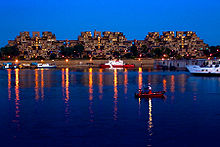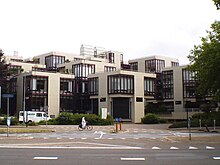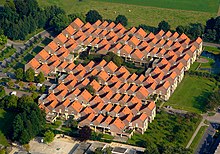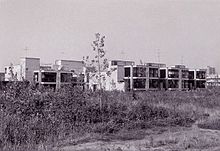Structuralism (architecture)
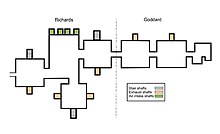
The structuralism is a mid-20th century arisen flow in architecture and urban planning . It is a reaction to CIAM functionalism ( rationalism ).
Under structuralism in a broader sense, a methodological and philosophical model is understood that emerged in the early 20th century in the field of linguistics and has been adopted by other disciplines and developed. Structuralist methods were used in linguistics , anthropology , philosophy , the fine arts and architecture .
The Dutch architects of structuralism were engaged in similar investigations as Claude Lévi-Strauss (anthropology) and referred to the principle "Langue et parole" by Ferdinand de Saussure (linguistics), especially on the subject of participation in the sense of structure and interpretation.
A definition that can be used in both human sciences and architecture has been formulated in Wikipedia's general structuralism article. This reads as follows: "Structuralism is a theoretical paradigm with the principle that elements of human culture are related to a superordinate system or structure."
A quote from Simon Blackburn is also included: “Structuralism assumes that the phenomena of human life are incomprehensible without their internal connections. These relationships form a structure and behind every local variation of phenomena there are constant laws of abstract culture. "
Structuralism and Postmodern Architecture
In Europe, structuralist architecture developed into a counter-model to functionalist architecture in the 1960s . Architectural critics such as Jürgen Joedicke and Kenneth Frampton gave structuralism a high priority. In the 1970s, it was ousted by postmodern architecture , which was spread worldwide through publications and lectures by authors such as Charles Jencks , Robert Venturi and Denise Scott Brown and which became the dominant trend in architecture for decades.
Significant theoretical contributions to structuralism came from Europe and Japan . Structuralism became well known in the German-speaking world through Arnulf Lüchinger . A renewed interest in structuralism can be seen from the 2010s. In 2011, a comprehensive compilation of "structuralist activity" (quote from Roland Barthes ) with the title Structuralism Reloaded was published , in which 47 authors dealt with philosophical, historical, artistic and other relevant aspects of structuralism.


A few months after the publication of the book Structuralism Reloaded , the RIBA Institute in London discussed the new candidates for the RIBA Gold Medal 2012. The question arose: “Should the RIBA Gold Medal be presented to the Venturis this year ?” However, it was not the post-modernist view of the Venturis that was rewarded at the award ceremony, but the structuralist view of Herman Hertzberger . A shift in emphasis had taken place. Former RIBA President Jack Pringle commented: "The prestigious British award, the RIBA Gold Medal, should be given to an architect who moves us forward, not backward." Today, postmodern architecture can be compared to a certain extent be with the European current of traditionalism .
Different directions
The anthropologist Claude Lévi-Strauss remarked: “I don't think there is any single structuralism to speak of. There are a number of directions that are called structuralism. ” This versatility also occurs in structuralism in architecture, which, however, has an autonomy that does not correspond to all the principles of structuralism in the human sciences. Diversity in architecture creates different appearances.
Aesthetics of the number
Aldo van Eyck formulated the term “aesthetics of number” in 1959. This architecture can be compared with cell tissue. Aldo van Eyck's orphanage in Amsterdam, which was completed in 1960, is an influential prototype of this direction. The “aesthetics of number” is also referred to as “configurative architecture”. The appearance cannot be changed.
Structure and filling - participation
John Habraken introduced the terms “structure and filling” and “architecture of lively diversity” in 1961 for user participation in residential construction. At the same time, in the 1960s, various utopian projects were created based on the principle of “structure and filling”. An influential prototype of this direction is the cultural center in Kofu by Kenzo Tange from 1967. It is an interpretable, adaptable and expandable building. With regard to participation in residential construction, Herman Hertzberger used the terms "architecture as a semi-product" or "open structures" and Alejandro Aravena the terms "participatory design process" and "half-houses".
The building design is not clearly predetermined, architecture is understood as a process with an open outcome. As a result, conventional design rules lose their meaning. The structures built and to be built are understood as expressions of social and functional relationships. Certain aesthetic and configurative design schemes of the multiplication of module and basic geometric shapes are used. Often a basic structure, a module or a grid is developed from this theoretical approach, which is intended to be subject to a constant growth or restructuring process with the participation or at the discretion of the users.
Emergence

Structuralism in architecture and urban planning emerged in the CIAM ( Congrès International d'Architecture Moderne ) architects' association after the Second World War. From 1928 to 1959 the CIAM was one of the most important discussion platforms for architecture and urban planning. In this organization, various groups operated with partly contradicting views: supporters of a scientific architecture without aesthetic premises ( rationalists ), supporters of architecture as building art ( Le Corbusier ), supporters of high-rise or low-rise buildings ( Ernst May ), supporters of a reform course after the second World War ( Team Ten ), followers of the "old doctrine" and others.
The following formulation in the CIAM Declaration of 1928 comes from architects of rationalism. One of the first to rebel against this view was Aldo van Eyck with his "Statement Against Rationalism" at the sixth CIAM congress in 1947. The criticized quote from 1928 reads:
"Urban planning can never be determined by aesthetic considerations, but only by functional inferences."
It was individual members of the international splinter group Team Ten who laid the basis for structuralism. At the last CIAM congress, organized by Team Ten and held in 1959 in the Kröller-Müller Museum in Otterlo , their ideas fell on fertile ground. Therefore, this point in time is of great importance for the implementation of structuralist thinking in architecture and urban planning. Later, Herman Hertzberger , a main representative of the second generation, interpreted the influence of this team as follows: “I am a product of Team Ten.” Team Ten as an avant-garde group was active from 1953 to 1981, with two different architectural currents emerging from this team . On the one hand it was the brutalism of the English representatives ( Alison and Peter Smithson ) and on the other hand the structuralism of the Dutch representatives (Aldo van Eyck and Jacob Bakema ).
Important impulses for structuralism also came from outside Team Ten, for example from Louis Kahn in the United States, Kenzō Tange in Japan and the Dutchman John Habraken with his theory of user participation . Herman Hertzberger , Lucien Kroll and Alejandro Aravena made significant architectural contributions for participation in residential construction .
The Japanese architect Kenzo Tange designed the famous master plan for Tokyo Bay in 1960 . He later reported on the development phase of this project: “I think it was around 1959 or the early 1960s that I was occupied with a movement that I later called structuralism.” Tange went on to write the article “Function, structure and symbol , 1966 ”, which describes the transition from functionalist to structuralist thinking. For Tange, the period from 1920–60 was under the sign of functionalism and the period from 1960 under the sign of structuralism.
Various early projects and built prototypes for structuralism come from Le Corbusier, some of them even from the 1920s. Although the members of Team Ten criticized certain aspects of Le Corbusier's work in the 1950s - such as the basic urban planning concept without a "sense of place" (according to Van Eyck "sense of place", according to Hertzberger "sense of place") and the The dark inner streets of the Unité - they saw him nonetheless as a great role model for a creative architect.
manifest
One of the most influential manifestos for the structuralist movement was compiled by Aldo van Eyck in the journal Forum 7/1959. It was also the program for the international architecture congress CIAM XI 1959 in Otterlo , the eleventh and last of these conferences. After the congress, the CIAM was canceled by Team Ten. The core of the manifesto is a head-on attack on the Dutch representatives of CIAM rationalism, who were responsible for the reconstruction after World War II (the planners van Tijen, van Eesteren , Merkelbach and others were not named for tactical reasons). The manifesto contains many statements and models for a more humane urban development. The Otterlo Congress is often named as the beginning of the architectural movement structuralism, although earlier projects and buildings of the new movement existed. The term structuralism has only been used in the specialist literature on architecture since 1969.
Another influential manifesto is the book “The Porters and the People - The End of Mass Housing ” by John Habraken , published in 1961. It is seen as the beginning of participation in housing construction and as part of the architectural movement structuralism. The manifesto appeared in the languages: Dutch, English, Italian, Spanish and German.
Otterlo Congress and its participants
Individual presentations and discussions at the Otterlo Congress in 1959 are seen as the beginning of structuralism in architecture and urban planning. These presentations were influential internationally. In Oscar Newman's book with the title CIAM '59 in Otterlo , the 43 participating architects are named and sorted by origin:
- L. Miquel, Alger
- Aldo van Eyck , Amsterdam
- José A. Coderch , Barcelona
- Wendell H. Lovett, Bellevue-Washington
- Werner Rausch, Berlin
- Willy van der Meeren, Bruxelles
- Ch. Polonyi, Budapest
- M. Siegler, Geneva
- Paul Waltenspühl , Geneva
- Hubert Hoffmann , Graz
- Christian Farenholtz , Hamburg
- Alison Smithson , London
- Peter Smithson , London
- Giancarlo De Carlo , Milan
- Ignazio Gardella , Milan
- Vico Magistretti , Milan
- Ernesto Nathan Rogers , Milan
- Blanche Lemco van Ginkel, Montreal
- Daniel van Ginkel, Montreal
- Callebout, Nieuport
- Geir Grung, Oslo
- Arne Korsmo, Oslo
- Georges Candilis , Paris
- Alexis Josic, Paris
- André Wogenscky, Paris
- Shadrach Woods , Paris
- Louis Kahn , Philadelphia
- Viana de Lima, Porto
- Fernando Tavora, Porto
- Jacob Bakema , Rotterdam
- Herman Haan, Rotterdam
- JM Stokla, Rotterdam
- John Voelcker, Staplehurst
- Ralph Erskine , Stockholm
- Kenzo Tange , Tokyo
- T. Moe, Trondheim
- Oskar Hansen, Warsaw
- Zofia Hansen, Warsaw
- Jerzy Soltan, Warsaw
- Fred Freyler , Vienna
- Eduard F. Sekler , Vienna
- Radovan Niksic, Zagreb
- Alfred Roth , Zurich.
Definition of the structuralist form
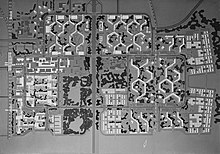



Since there are several directions in structuralism, there is also more than one definition. A well-known and much-cited definition comes from Herman Hertzberger : "With structuralism, a distinction is made between a structure with a long life cycle and fillings with a less long cycle."
Hertzberger published a more detailed description of this definition in 1973. On the one hand, it is a general definition and, on the other hand, a definition of form for user participation in residential and office construction: "That we emphasize the term 'form' over 'space' or 'architecture' means nothing more than an accent shift. However, we are dealing with a different concept of form than the usual one, which assumes a formal and unchangeable relationship between object and viewer. For us, it is not the form of appearance as the wrapping of the object that comes first, but the form as a potential carrier of content and meaning. The form can be filled with content, values and meanings, but they can also be disposed of again without changing significantly. All of this happens in the same way as the user and the form play together and play with each other. We want the meaning-absorbing, meaning-carrying and transferring ability of the form to determine what is achieved with the user and, conversely, what the users achieve with the form. We are concerned with the interaction between form and user, what they convey to one another and how they mutually take possession of one another. - We have to shape the material of the things that we manufacture in such a way that, in addition to its function in the narrower sense, it is also suitable for several purposes. It should be able to play many roles in the service of the various individual users, so that everyone can react to it personally and interpret it in their own way. Only then does it fit into the familiar environment and can make a positive contribution to it. ” Page 56
In comparison to other directions of structuralism in architecture, the following specifications were noted: “With the new architectural trend, there is often a tendency to describe everything as structuralist that resembles a woven fabric and has a grid. That would be a superficial view. In essence, structuralism is about the configuration of conditioned and polyvalent space, communication, construction or other form units in all sizes of the city. Only when the structures have been taken into possession by touching, interpreting or filling in, have they reached their full-fledged state. This means that architecture tending towards formalism is excluded. The much-discussed 'flexible' form as a neutral envelope is also rejected, as it does not offer the right solution for any space program. In the architecture of Herman Hertzberger, the structural design can be found from the smallest detail to the complex structure, whether it is room, facade or environment design. ” Page 58
The following text deals with structuralism in the general sense and with the autonomy of the primary structure: “Different structuralists would describe a structure roughly as follows: It is a whole of relationships in which the elements can change in such a way that they remain dependent on the whole and get their meaning. The whole is independent in relation to the elements. The relationships between the elements are more important than the elements themselves. The elements are interchangeable, but the relationships are not. ” Page 16
Theoretical starting points
In addition to the formal aspects of "aesthetics of number" and "architecture of lively diversity" ("structure and filling") mentioned above, the following sections are designated as ideological starting points:
- "Built structures as a contraform of social structures" according to Team Ten, which called itself a "working group for the investigation of the relationships between social and built structures".
- “ Archetypal human behavior” as the starting point for architecture (compare anthropology , Claude Lévi-Strauss ). In contrast to this view, various rationalists , influenced by groups of the Russian avant-garde of the 1920s, believed in a manageable person in a manipulable society.
- »Connection, growth and change« at all stages of urban development. "Structure of the building mass" with design quality. »Sense-of-Place-Concept« (according to Van Eyck "Sense for the place", according to Hertzberger "Sense for places"). "Identification mark".
- "Polyvalent form and individual interpretation" (compare Langue et Parole , Ferdinand de Saussure ); » User participation «; »Integration of professional and everyday building culture« with the result of »pluralistic architecture«.
Application of the principles
The principle of “structure and filling” has remained relevant to this day, both for architecture in residential construction and for urban planning. The following images were influential for user participation in housing construction: the perspective drawing of the “Fort l'Empereur” project in Algiers by Le Corbusier (1934), the isometric drawing of the changeable housing estate “Diagoon” in Delft by Herman Hertzberger (1971) and the housing estates with Participation of Alejandro Aravena in our time. At the city level, the following images were influential: the Tokyo Bay plan by Kenzo Tange (1960) and the fascinating model photos of the Free University of Berlin by Candilis Josic & Woods (1963). The principle of “structure and filling” also occurs in earlier urban structures (see: planned city ). - In today's discussion, Herman Hertzberger's term “open structures” has become topical. In this context, the projects by Archigram , Yona Friedman and other utopians should also be mentioned.
The “aesthetics of number” principle has proven to be unsuitable for structuring an entire city. However, it was used in architecture and housing developments. Aldo van Eyck provided the first influential images of this direction with aerial photos of his orphanage in Amsterdam (1960). He later realized the Estec space center in Noordwijk (1989). These two buildings by Aldo van Eyck are more unchangeable works of art than open structures.
Projects and built examples
Individual buildings
- Giorgi Tschachawa and Zurab Djalagania: Administration building of the Ministry of Road Construction , Tbilisi, Georgia, 1975.
- Herman Hertzberger : Centraal Beheer administration building in Apeldoorn, 1972 (office space with participation) / De Drie Hoven, old people's home, Amsterdam-Slotervaart 1974.
- Fritz Haller : Dorigny teaching and research center at the ( ETH Lausanne ), competition project 1970.
- Kenzo Tange : Press Center in Kofu, 1967 / Fuji Television Building in Odaiba, Tokyo, 1996.
- Candilis , Josic & Woods : Humanities Institutes at the Free University of Berlin (“Rostlaube”) , 1963–73. (Covered road structure with infills).
- Aldo van Eyck : Orphanage Amsterdam, 1960 / European Space Research and Technology Center in Noordwijk (restaurant, congress halls, library), 1989.
- Louis Kahn : Trenton Bath House in Ewing, New Jersey, 1954 (part of a larger project) / Salk Institute for Biological Studies in La Jolla, California, 1965 / Kimbell Art Museum in Fort Worth, Texas, 1972.
- Le Corbusier : Weekend house in La Celle-Saint-Cloud near Paris , 1935 / Center Le Corbusier in Zurich 1963.
Housing estates


- Piet Blom : Kasbah in Hengelo , 1973 / Cube houses in Rotterdam 1985 and Helmond 1975
- Verhoeven Klunder Witstok & Brinkman: Berkel-Rodenrijs , 1973.
- Moshe Safdie : Habitat 67 , World's Fair in Montreal ., 1967
- Giancarlo De Carlo : Student Housing, Collegio del Colle Urbino , 1966.
- Stefan Wewerka : Ruhwald in Berlin , project 1965.
- Atelier 5 : Halen settlement near Bern , 1961.
- Kenzo Tange : Tokyo Bay Plan, 1960. City expansion with units of large housing estates .
- Alison and Peter Smithson : Golden Lane London , Project 1953 / Urban Development Scheme Hierarchy of Association, 1953.
- Van den Broek & Bakema , Jan Stokla: Housing estates near Rotterdam : Pendrecht, project 1949 / Alexanderpolder, projects 1953 and 1956.
Housing estates with participation
- OMA , Rem Koolhaas office : Homeruskwartier in Almere . Master plan and coordination, houses by different architects, mix of architectural styles, 2012.
- Alejandro Aravena : Social housing with half-houses for participation in: Iquique (Chile) , Quinta Monroy , 2004 / Santiago de Chile , Lo Espejo, Don Francisco, 2007 / Monterrey ( Mexico ), Las Anacuas, 2010 / Constitución (Chile) , Villa Verde, Rio Loncamilla, 2016.
- Adriaan Geuze : Borneo-Sporenburg, Scheepstimmermanstraat Amsterdam . Master plan and coordination, houses by various architects, cubist architectural style, 1997.
- Lucien Kroll: Student Center St. Lambrechts-Woluwe near Brussel , partial student participation, 1976.
- Ottokar Uhl : Hollabrunn , 1972 / Vienna , Wiener Gasse 6, 1984 / Vienna, Jeneweingasse 32, 1984.
- Herman Hertzberger : 8 "Diagoon" terraced houses in Delft , architecture as a semi-product for participation: interior, facade and surroundings, 1971.
- Le Corbusier : Fort l'Empereur project in Algiers , large housing estate with rounded facades for participation, filling of the houses by various architects, 1934.
Works of art
Memorial to the children in Yad Vashem Jerusalem , 1987 ( Moshe Safdie )
Holocaust Memorial in Berlin, 2005 ( Peter Eisenman )
Structure units
A striking feature of structuralism in architecture is the configuration with structural units in various designs. In the book Structuralism in Architecture and Urban Development , the buildings and projects are published under the following book titles:
- 1. Structures with building units
- 2. Structures with building group units
- 3. Structures with construction units
- 4. Structures with communication units (vertical units, horizontal units)
- 5. Other structures (without grid)
- 1. - Trenton Bath House, in Ewing Township NJ, part of a larger plan, 1955 ( Louis Kahn )
- 2. - Habitat 67 in Montreal , 1967 ( Moshe Safdie )
- 3. - Lovell Beach House in Newport Beach , 1926 ( Rudolph Schindler )
- 4a. - Yamanashi Culture Institute in Kofu , 1967 ( Kenzo Tange )
- 5. - Park Hill in Sheffield , 1961 (Lynn Smith Womersley)
Urban planning - historical models
In the magazine Forum 1/1964 John Habraken shows a fragment of the city map of Rome by Giovanni Battista Nolli from 1748. In this plan, Habraken points out the existence of two types of architecture: the "special architecture" (white) and the "everyday Architecture "(gray). Habraken himself deals with everyday architecture and is of the opinion that the architects still believe that they can deal with everyday architecture in the same way as with the particular architecture. In our time, an important representative of everyday architecture is the architect Alejandro Aravena , who realizes social housing estates with "half-houses" for the participation of the residents.
Plan of Rome 1748, particular architecture (white) and everyday architecture (gray)
Amsterdam 1660, structure and infill
Manhattan 1807, interpretable urban structure (still without Central Park )
Barcelona 1859, historic city and urban expansion
Topics of the team 10


Jacob Bakema and members of a reorganization committee of the CIAM proposed in 1957 to change the name "CIAM: Congrès Internationaux d'Architecture Moderne" to "CIAM: Groupe de Recherches des Interrelations Sociales et Plastiques" . Two years later the following overview with 18 topics was published in the journal Forum 7/1959 for the new "Working Group for the Study of the Relationship between Social and Built Structures" (Team 10) . This magazine was also the program for the CIAM '59 congress in Otterlo .
Topics of Team 10 on the cover of Forum 7/1959:
- cluster ─ (structure of residential areas and city)
- change and growth ─ (change and growth)
- à mi-chemin ─ (halfway in relation to other cultures)
- imagination versus common-sense ─ (art versus science)
- appreciated unit ─ (residential unit appreciation)
- la plus grand realité du seuil ─ (the in-between for the encounter of the residents)
- l'espace corridor ─ (against the spatial corridor of the row structure)
- stad als interieur van de gemeenschap ─ (city as interior of the community)
- identity ─ (identity of the architecture and the residents)
- het ogenblik van core ─ (city center and its meaning)
- hierarchy of human associations ─ (urban planning according to the structure of the community)
- mobility ─ (motion systems)
- l'habitat pour le plus grand nombre ─ (housing for the largest population group)
- harmony in motion ─ (harmony in motion, aesthetics of number)
- aspect of ascending dimensions ─ (aspect of increasing dimensions)
- identifying devices ─ ( identifying symbols of the city)
- gedifferentieerde wooneenheid ─ (differentiated residential unit)
- visual group ─ (living grouping that can be experienced visually)
Literature and Notes
- ↑ a b Aldo van Eyck, “Statement Against Rationalism”, for CIAM VI 1947, in: Aldo van Eyck - Writings , Amsterdam 2008. Statement against CIAM notions such as: “Urban planning can never be determined by aesthetic considerations, but exclusively by functional ones Conclusions. ” This formulation comes from rationalist architects and is in the 1928 CIAM declaration.
- ^ Francis Strauven, Aldo van Eyck - The Shape of Relativity , Amsterdam 1998 (1994). Biography about Aldo van Eyck and his “configurative discipline” of design.
- ^ Bernhard Denkinger: The forgotten alternatives - structuralism and brutalist experience in architecture . Jovis-Verlag, Berlin 2019, ISBN 978-3-86859-551-2 .
- ↑ Jürgen Joedicke: Architecture in Transition - History-Development-Outlook . Extended new edition. Original title Modern Architecture , 1969. Karl Krämer, Stuttgart 1980, ISBN 3-7828-0459-7 .
- ↑ Kenneth Frampton: "The Structural Regionalism of Herman Hertzberger". In: Labor, Work and Architecture - Collected Essays on Architecture and Design . London / New York 2002, ISBN 0-7148-4080-7 , pp. 289-297 .
- ↑ a b c d e f g h Arnulf Lüchinger, Structuralism in Architecture and Urban Development , Stuttgart 1980. With original texts by Herman Hertzberger, Louis Kahn, Le Corbusier, Kenzo Tange, Aldo van Eyck and other members of Team Ten.
- ↑ a b c d Tomáš Valena (eds.) With Tom Avermaete and Georg Vrachliotis, Structuralism Reloaded - Rule-Based Design in Architecture and Urbanism , Stuttgart-London 2011. 47 articles by Roland Barthes, Herman Hertzberger, Winy Maas u. a.
- ↑ a b c Aldo van Eyck, "Het Verhaal van een other thought" (The story of a different view), with the principle "aesthetics of number," in Forum 7/1959, Amsterdam-Hilversum. The editorial team of Forum 7 / 1959-3 / 1963 and July / 1967 consisted of Aldo van Eyck, Herman Hertzberger, Jacob Bakema and others. a.
- ↑ Aldo van Eyck, “De straling van het configuratieve” (“Steps towards a configurative discipline”), in: Forum 3/1962, Amsterdam-Hilversum.
- ↑ N. John Habraken, The Porters and the People - The End of Mass Housing Construction , The Hague 2000. About resident participation, in combination with 2-component construction - structure and chance . (Original edition De Dragers en de Mensen - Het Einde van de Massawoningbouw , Amsterdam 1961).
- ^ A b Reyner Banham, Megastructure - Urban Futures of the Recent Past , London 1976.
- ↑ a b c Max Risselada and Dirk van den Heuvel (eds.), Team 10 - In Search of a Utopia of the Present , Rotterdam 2005. Essays by 23 authors. Interviews with Georges Candilis, Giancarlo De Carlo, Balkrishna Doshi, Ralph Erskine, Herman Hertzberger, Alison and Peter Smithson, Aldo van Eyck.
- ↑ Kenzo Tange, “Function, Structure and Symbol, 1966”, in: Udo Kultermann, Kenzo Tange , Zurich 1970. Kenzo Tange in 1966: “We notice that we are not only occupying the rooms with a function but also with a structure have to. " Kenzo Tange in a lecture in 1981: " I think it was around 1959 or the beginning of the 1960s that I was concerned with a movement that I later called structuralism, " (published in Plan 2/1982, Amsterdam) .
- ^ Wim van Heuvel, Structuralism in Dutch Architecture , Rotterdam 1992. (Dutch edition and English edition)
- ↑ Arnaud Beerends, "Een Structuur voor het Raadhuis van Amsterdam" (A structure for the town hall of Amsterdam) in TABK 1/1969, Heerlen. Herman Hertzberger said in an interview about this article: "It was Arnaud Beerends who first used the term structuralism in the magazine TABK 1/1969 ... I expanded the term structuralism," (in: A +, Architecture in Belgium, 261_Hertzberger , Brussels October 4, 2016). Furthermore, according to Francis Strauven: "Dutch structuralism was recognized as an architectural trend and launched internationally by the Swiss architect Arnulf Lüchinger, since 1974," quote (in: Video Vimeo 2014, Francis Strauven Structuralisme, 04:40). It is striking that the term “structuralism” does not appear anywhere in Forum magazine (with editors Van Eyck, Bakema, Hertzberger and others). The last edition of this editorial team was Forum July / 1967. Here Herman Hertzberger referred to one of his articles as "A study in configuration". The first article with the title “Structuralism” appeared in an architecture magazine in Bauen + Wohnen 5/1974 by Arnulf Lüchinger, about the architecture by Herman Hertzberger. Development from “configurative discipline” to “superordinate system or structure” and “structuralism”.
- ↑ a b c d Oscar Newman (ed.), CIAM '59 in Otterlo , Stuttgart 1961. 30 articles by Louis Kahn, Kenzo Tange, Georges Candilis, Jacob Bakema, Aldo van Eyck, Alison and Peter Smithson and others, (English with German text supplement). The Otterlo Congress is widely seen as the beginning of structuralism in architecture, although nobody in Otterlo has talked about structuralism. The beginning was indicated by architectural interpreters in the 1970s.
- ↑ Herman Hertzberger, Vom Bauen - Vorlesungen über Architektur , Munich 1995. (English editions Lessons for Students in Architecture , Rotterdam 1991 No. 1, 2000 No. 2, 2008 No. 3). Definition by Herman Hertzberger: "With structuralism, a distinction is made between a structure with a long life cycle and fillings with a less long cycle."
- ^ Herman Hertzberger, "Dedicato a Schindler", in: Domus September No. 465/1967, Milan.
Literature - interpretations since 1959
- Lidwine Spoormans et al. a., The Future of Structuralism , TU Delft Open, Delft 2020.
- Bernhard Denkinger , The Forgotten Alternatives - Structuralism and Brutalist Experience in Architecture , Berlin 2019.
- Herman Hertzberger , Architecture and Structuralism - The Ordering of Space , Rotterdam 2015 (2014).
- Alejandro Aravena and Andrés Iacobelli, Elemental - Incremental Housing and Participatory Design Manual , Berlin 2012.
- Joaquin Warmburg and Cornelie Leopold (eds.), Structural Architecture , Bielefeld 2012.
- Tomas Valena (ed.) With Tom Avermaete and Georg Vrachliotis, Structuralism Reloaded - Rule-Based Design in Architecture and Urbanism , Stuttgart-London 2011. 47 articles by international authors.
- Rivka Oxman and Robert Oxman (Eds.), “The New Structuralism - Design, Engineering and Architectural Technologies”, in: Architectural Design July / August 2010, London.
- Mark Garcia (Ed.), "Patterns of Architecture", in: Architectural Design November / December 2009, London.
- Sabrina van der Ley and Markus Richter (eds.), Megastructure Reloaded - Visionary urban designs from the 1960s reflected by contemporary artists , Ostfildern near Stuttgart 2008.
- Michael Hecker, Structurel-Structural , Influence of structuralist theories in West Germany from 1959–1975, dissertation TU Stuttgart 2007.
- Max Risselada and Dirk van den Heuvel (eds.), Team 10 - In Search of a Utopia of the Present , Rotterdam 2005. Essays and interviews by 23 international authors.
- Francis Strauven, Aldo van Eyck - The Shape of Relativity , Amsterdam 1998 (1994). Biography about Aldo van Eyck and his “configurative discipline” of design.
- Wim van Heuvel, Structuralism in Dutch architecture , Rotterdam 1992.
- Hans van Dijk, "The demise of structuralism" (The end of structuralism), in: Architecture in the Netherlands - Yearbook 1988/1989 - Dutch Architectural Institute Rotterdam, Deventer 1989.
- Jürgen Joedicke , Architecture in Transition , Stuttgart 1980.
- Anders Ekholm, Nils Ahrbom, Peter Broberg, Poul-Erik Skriver, Strukturalism i Arkitekturen , Stockholm 1980.
- Reyner Banham , Megastructure - Urban Futures of the Recent Past , London 1976.
- Alison Smithson , "Mat-Building, mainstream architecture as it has developed towards the mat-building", in: Architectural Design 9/1974, London.
- Arnulf Lüchinger , "Structuralism", in: Bauen + Wohnen 5/1974, Zurich-Munich - "Structuralism, a new trend in architecture", in: Bauen + Wohnen 1/1976, Zurich-Munich - "Dutch Structuralism", in : Architecture + Urbanism 3/1977, Tokyo - Structuralism in Architecture and Urban Development , Stuttgart 1980 - 2-component construction , The Hague 2000 (participation).
- Justus Dahinden , Urban Structures for Tomorrow , Stuttgart 1971.
- Udo Kultermann , “Introduction”, in: Kenzo Tange , Zurich 1970. Udo Kultermann introduces the term “structurism” as one of the “characteristics of current development”.
- Arnaud Beerends, “Een structuur voor het Raadhuis van Amsterdam” (A structure for the city hall of Amsterdam), in TABK 1/1969, Heerlen. The terms structuralism and structuralists are published for the first time in this journal, in the sense of the "configurative discipline" of designing with the same building units.
- Kenzo Tange , "Function, Structure and Symbol, 1966," in: Udo Kultermann, Kenzo Tange , Zurich 1970. Structural process in architecture and urban planning. In a lecture in 1981 Kenzo Tange said: "I think it was 1959 or the early 1960s that I was dealing with a current that I later called structuralism" (in: Plan 2/1982, Amsterdam).
- N. John Habraken , The Porters and the People - The End of Mass Housing . Beginning of the participation movement, structure and individual fillings. Editions: Dutch 1961, English 1972, Italian 1974, Spanish 1975 and German 2000 (with illustrations). The third edition of Supports will appear in 2020 in the series "Routledge Revivals".
- Oscar Newman (ed.), CIAM '59 in Otterlo , Stuttgart-London-New York 1961. 30 articles by Louis Kahn, Kenzo Tange, Georges Candilis, Jacob Bakema, Aldo van Eyck, Alison and Peter Smithson and others (English with German Text attachment).
- Aldo van Eyck , “Het Verhaal van een other thought” (The story of a different view), in: Forum 7/1959, Amsterdam-Hilversum. Program for the CIAM '59 congress in Otterlo . Since the 1970s, the Otterlo Congress has been seen as the beginning of the architectural movement structuralism. The term structuralism in architecture first appeared in a specialist journal in 1969.
See also
Online videos
Lectures by Bart Lootsma at the University of Innsbruck (2015).
- Structuralism 1 Claude Lévi-Strauss , ...
- Structuralism 2 CIAM , Team Ten , ...
- Structuralism 3 Forum, Bakema , ...
- Structuralism 4 Van Eyck , Hertzberger , Blom , ...

